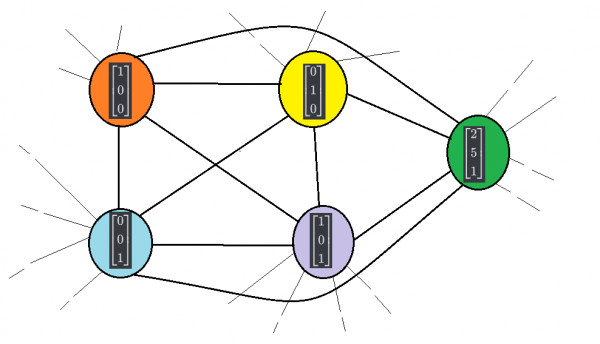Lets consider the vectors in $\mathbb{R}^3{}$ space =
Set S = $\begin{cases} &\begin{bmatrix}a \\ b \\ c \end{bmatrix} \left.\begin{matrix} \\ \\ \end{matrix}\right| \forall a,b,c \in \mathbb{R} \end{cases} \left.\begin{matrix} \\ \\ \\ \end{matrix}\right\}$
i.e, $\begin{cases} & \begin{bmatrix}1 \\ 0 \\ 0 \end{bmatrix} \end{cases}$$,\begin{bmatrix}0 \\ 1 \\ 0 \end{bmatrix}$,$\begin{bmatrix} 0 \\ 0 \\ 1 \end{bmatrix}$,$\begin{bmatrix} 1 \\ 0 \\ 1 \end{bmatrix}$,$\begin{bmatrix} 2 \\ 5 \\ 1 \end{bmatrix}$,………...$\left.\begin{matrix} \\ \\ \\ \end{matrix}\right\}$
Lets disprove the options one by one…
A pair of vectors $\vec{x}$ and $\vec{y}$ are linearly independent if and only if one vector cannot be represented as scalar multiple of other vector
i.e, $\begin{cases} &\begin{bmatrix}a \\ b \\ c \end{bmatrix},\begin{bmatrix}x \\ y \\ z \end{bmatrix} \left.\begin{matrix} \\ \\ \end{matrix}\right| \forall i \in \mathbb{R} \end{cases}, i*\begin{bmatrix}a \\ b \\ c \end{bmatrix} $$\neq$$ \begin{bmatrix}x\\ y \\ z \end{bmatrix} \left.\begin{matrix} \\ \\ \\ \end{matrix}\right\}$
For eg : $\left\{\begin{matrix} \\ \\ \\ \end{matrix}\right.\begin{bmatrix}1\\ 0\\ 0\end{bmatrix} ,\begin{bmatrix}0 \\ 1 \\ 0 \end{bmatrix} \left.\begin{matrix} \\ \\ \\ \end{matrix}\right\}$ is a pair of linear independent vectors
Conider the below graph

Here we can see that the size of the clique is 5 where d = 3 ,we can eliminate Option B right away…
Option C can be disproven by considering a set of 6 vectors (m=6) taking above five vectors in the set along with any other vector
{ m/2 = 3 but the size of the clique is 5 }
The maximum degree of a vertex can be anything hence Option D can be eliminated
For every vector in set ,there exist atleast one corresponding linear independent vector to which it makes
up an edge in the graph . Hence Option A is eliminated as no vertex can be idle without an edge incident on it…
Hence Option E is the answer…...